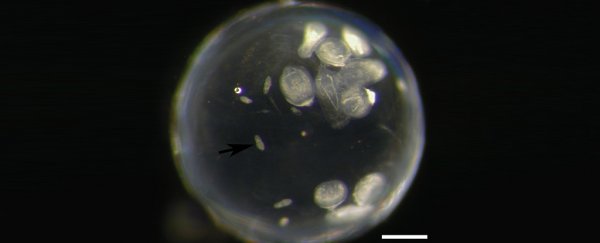Biology is really one big horror story. You don't need to look much further than the various types of parasites that drive their hosts into the mouths of hungry predators.
If you're keeping track of these tiny monsters, you should know that there's a species of flatworm that parks itself inside the eyeball of a fish, and controls when its host hides from birds or exposes itself to be eaten - all to benefit its very complicated (and creepy) life cycle.
A team led by the Severtsov Institute of Ecology and Evolution in Moscow, Russia found that a common parasite called an eye fluke, Diplostomum pseudospathaceum, evolved this rather gruesome way of navigating its way through its somewhat complex life cycle.
The fluke relies on three different animals to develop from egg to adult:
- It mates in a bird's digestive tract, where the eggs pass into the water with the bird's faeces
- Larvae hatch from the eggs and seek out a freshwater snail to burrow into, where they mature and reproduce asexually
- The next stage of larvae, free-swimming forms of the parasite called cercariae, leave the snail and then dig their way through a fish's hide for their final journey, which ends in the lens of the animal's eyeball in a stage called metacercariae
- A bird eats the fish, infected eyeballs and all, and the fun begins all over again.
Studies had shown that the parasite can affect the host's vision, which was suspected to help the fluke by making it harder for the fish to detect predators.
Researchers conducting this new study weren't convinced that there was a lot of evidence for this, so in 2015 they set out to study the behaviours of infected rainbow trout (Oncorhynchus mykiss) by dosing around 25 fish with immature flukes.
While the trout usually swam less vigorously, a researcher tasked with catching them with a dip net – unaware of which fish were infected and which weren't – found the infected fish a little harder to catch.
Both of these behaviours would help the trout avoid being spotted and nabbed by a bird before the flukes had a chance to grow into sexually mature adults.
While the host's behaviour clearly changed, it didn't seem to be due to any induced blindness.
"In our study, manipulations of the host behaviour arose when metacercariae were small and host vision impairment due to cataract formation was unlikely," they wrote in their 2015 paper.
If the parasite was pulling any strings, it was through chemistry rather than simply blocking out the light inside their eyeball.
Now, in their most recent study, the team noticed there were in fact two distinct forms of behaviour, most likely differentiated by changes in the maturity of the flukes.
Once they'd moved through whatever the fluke equivalent of puberty is, it was game on - the researchers noticed that the trout became more active and moved closer to the surface.
They also found that while both infected and non-infected fish would freeze as the silhouette of a bird passed overhead, the infected ones started moving sooner.
The evidence suggests that the fish are being manipulated by their tiny hitchhikers to avoid being eaten while young, and then head for the bird's gut when old enough to reproduce sexually.
"Our findings suggest that immature larvae of D. pseudospathaceum induce changes in host behaviour that can protect them from predation," the researchers wrote in their 2015 study.
They now add in this new paper that the more mature "metacercariae can change rainbow trout's behavior predisposing them to avian predation".
Of course, eye flukes aren't the only nightmare fuel parasites out there.
Toxoplasmosis gondii is a well-known single-celled parasite that infects rodents and turns them into suicidal cat-lovers, even long after the parasites have cleared out.
A fungus called Ophiocordyceps unilateralis – known for its ability to turn insects into zombies that hold onto plant material for dear un-life – is so terrifying in concept it became inspiration for fungal-infected zombies in The Last of Us.
Want another horrid example?
How about a distant cousin to the eye fluke called a green-banded broodsac (Leucochloridium paradoxum), which produces striped sacs of larvae that push into its host snail's eyestalk, where it turns the snail into a Smörgåsbord by making its head look like a delicious worm.
Blinded, the snail crawls out into the light, where it can be eaten by birds.
Of course, maybe you're on Team Parasite, in which case the eye fluke is just one more fascinating example of evolution making use of the tools close at hand. Ick.
Both research papers were published in Behavioural Ecology and Sociobiology, found here and here.
